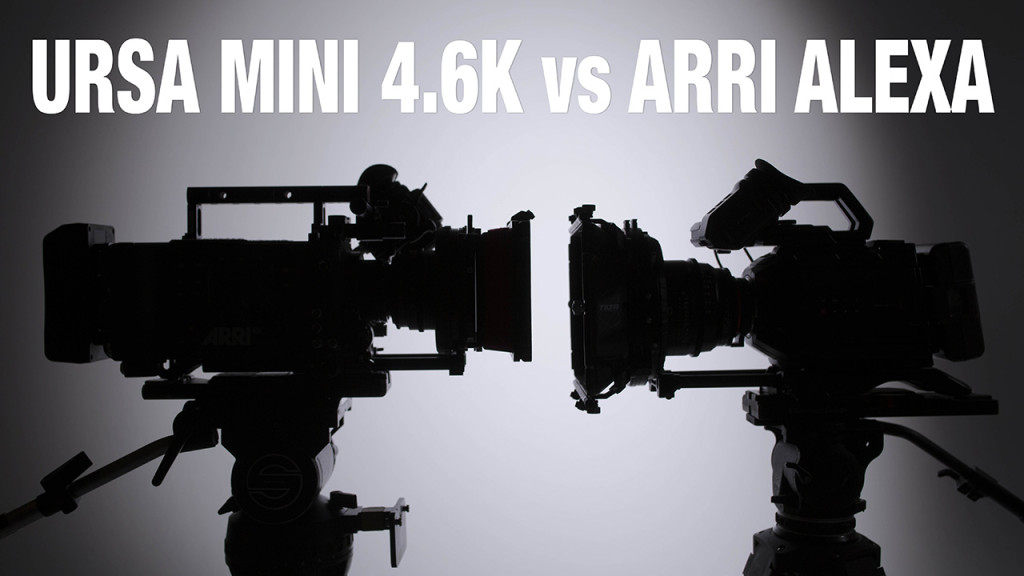Download my photo/video Business Coaching Class today and I’ll help you grow your business. 
Shop our affiliate links to support new content from The Slanted Lens.
Hi, this is Jay P. Morgan. Today on The Slanted Lens my friend Kenneth Merrill and I are taking the Blackmagic URSA Mini 4.6k and the ARRI Alexa head to head to see how their dynamic ranges match up. The Alexa is the standard against which other cameras are compared, and we wanted to see how the Mini would stand up against it.
We set up a model in front of a white background with different color dresses in the frame and looked at under and overexposing. We wanted to see how much info we’d be able to retain when we attempted to bring it back in post.
We realized we couldn’t use the same lens with both cameras because the mounts were different. The URSA does have a PL mount, which is the same as the Alexa, but we had the EF mount. We had a Zeiss Contax rehoused on the Alexa, so we rented an EF mount lens Contax lens to put on the URSA Mini so we could get the footage to match as close as possible. Unfortunately once Kenneth pulled it into post he realized the f-stop markers on the URA Mini lens were completely off. He ended up putting both lenses on his Red, which has both a PL and an EF mount, and shot a range of exposures and was able to match the t-stop on the PL mount lens to the f=stop on the EF mount lens. So in the video the URSA Mini exposure will read “+ 1 2/3 stop,” or “+ 3 1/3 stop.” You won’t see the exact +2 or +3, but Kenneth was able to match it pretty closely. You’ll be able to see how the camera behaves in under and overexposure situations.
We do need to say we are comparing a $6,000 camera to a $40,000. So the fact that we can even compare them says a lot about Blackmagic and how far the technology has come.
The Alexa shifts a little bit green, which is typical of most digital cameras. Not a big deal, it can be edited in Premiere or other post software. The URSA Mini tended warmer, which I actually like.
We exposed for the light on the key side of the face. The fill side was about -3 stops. We started to have to push the color as we got more overexposed in the URSA. The Alexa looked almost exactly the same, even as got into +5 stops. The closest we got to +5 with the URSA was +4 2/3, at which point we had clipping in the highlights. That started to happen at about +4 stops. That’s really nothing to be ashamed of. The Alexa finally started clipping at +6 stops. At that point with the URSA the footage was unusable.
Now for underexposure the URSA Mini actually did better. The Alexa started to show loss of detail and noise at -2 stops. The URSA didn’t have that problem, but it did start to lose the color. The Alexa became unusable at -4 stops. The color still looked amazing but the noise was too much. On the other hand, the color on the URSA was not good but the noise was almost non-existent.
We moved outside with the URSA where we had shade to open sunlight. We had overexposed cement in the background and our subject was in the shade. There was little detail, but no clipping, in the cement. And the shadows had plenty of detail. The movement feels very cinematic and comfortable. The clip we’re showing had very little done in the color. Our model’s makeup was a little orange. Just a boost to the contrast ti fill the scopes and boosted the contrast so it wasn’t as flat.
This camera is really for people looking to go from a DSLR, Canon C100 or Sony FS5 type camera to a ProRes or raw camera that’s shooting cinematic imagery. You’re going to have so much more dynamic range along with being able to push the footage since it’s raw. The camera itself felt good to handle. It wasn’t too heavy, it was comfortable. The Alexa is about 35lbs, this kitted out is about 12. Another thing to note is the battery life. We shot for 2 hours on a 90 watt battery. So instead of spending $2000 on batteries, like on the Alexa or a Red, you’ll spend about $1200. It has a great screen, and an optional viewfinder.
Blackmagic has historically had some technical issues. Kenneth has friends who have had to return products several times. John Brawley, a beta tester for Blackmagic, says it may be hard to get a good camera but once you do, they’re solid all the way through.
This camera is definitely great for it’s price point. Test this before you go out and spend the money on it. But it’s a great camera.
Keep those cameras rollin’ and keep on clickin’.
-Jay P.

